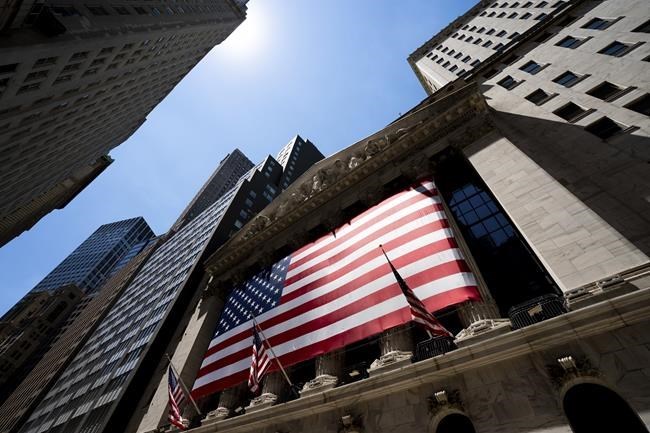NEW YORK (AP) — Stocks drifted to a mixed close as momentum stalled following Wall Street’s hot first half of November. The S&P 500 rose 0.1% Thursday. The Dow slipped 45 points, and the Nasdaq composite rose less than 0.1%. Walmart and Cisco slumped after giving disappointing forecasts. Oil companies also fell sharply after crude dropped to its lowest price since July. Wall Street is still on track for its best month in a year on hopes the Federal Reserve will take it easier on interest rates. Treasury yields sank after more reports bolstered hopes the economy is cooling enough to no longer need rate hikes to slow it down.
THIS IS A BREAKING NEWS UPDATE. AP’s earlier story follows below.
NEW YORK (AP) — Stocks are drifting Thursday following some unnerving profit forecasts from Walmart and Cisco Systems, but they're holding onto most of their big gains for November as Wall Street's hopes for a “Goldilocks” economy that's just right for markets keep rising.
The S&P 500 was virtually unchanged in late trading, and it remains comfortably on its way to a third straight winning week. The Dow Jones Industrial Average was down 124 points, or 0.4%, as of 3 p.m. Eastern time, and the Nasdaq composite was basically flat.
Walmart dropped 8.1% after it warned that shoppers began pulling back on spending late last month. It also gave a forecast for upcoming holiday profit that was weaker than analysts expected. The nation’s largest retailer’s stock fell even though it reported results for the latest quarter that edged past Wall Street’s expectations.
Cisco tumbled 11.5% even though it also reported stronger results for the latest quarter than analysts estimated. The company saw a slowdown of new product orders last quarter, and it gave forecasts for earnings this upcoming quarter and fiscal year that were weaker than analysts expected.
Stocks in the oil-and-gas industry were also particularly weak after the price of crude tumbled sharply to its lowest since July. ConocoPhillips dropped 3%, and Chevron fell 1.9%.
November nevertheless remains on track to be the S&P 500's best month in a year. Hopes have climbed that inflation is cooling enough to convince the Federal Reserve to halt its hikes to interest rates following its fusillade since last year. That’s in turn pushed expectations up for when the Fed could begin cutting rates, which can act like steroids for financial markets, in the summer.
Several more reports on Thursday indicated the economy is slowing. While the weaker-than-expected data are of course a signal the economy may be losing some of its strong momentum, for investors, they just as importantly show that upward pressures on inflation may be easing.
The Fed has been trying to shepherd the economy along a tightrope, to slow enough to stamp out high inflation without falling into a recession. Thursday's weaker-than-expected reports strengthened investors' hopes that the Fed can go easier on interest rates, which triggered an immediate drop in Treasury yields.
The yield on the 10-year Treasury fell to 4.44% from 4.54% late Wednesday. Just last month, it was above 5% at its highest level since 2007 and raising worries on Wall Street as it undercut prices for stocks and other investments.
On the winning side of Wall Street was Macy’s, which jumped 4.6% after delivering a surprising profit for the latest quarter.
Some economists and analysts are warning investors that they’ve become overzealous in predicting when the Fed could begin cutting rates. Even if the Fed is done hiking its main interest rate, officials at the central bank have said they’ll likely keep it high for a while to ensure inflation is truly stamped out. The federal funds rate is above 5.25% and at its highest level since 2001.
But investors have been paying more attention to recent data reports showing a slowdown in the economy. On Thursday, one said that slightly more workers applied for unemployment benefits last week. The number is still low relative to history, but a softening in the job market could prevent the too-strong raises in workers’ pay that the Fed fears could trigger a vicious cycle that keeps inflation high.
Separate reports said that manufacturing in the mid-Atlantic region is unexpectedly weakening, while U.S. industrial production weakened more than expected in October.
A slowing economy would also mean softer growth in demand for fuel, and worries are already high about swelling inventories for crude oil. A barrel of benchmark U.S. crude for delivery in December tumbled $3.76 to settle at $72.90. Brent crude, the international standard, also dropped $3.76, to $77.42 per barrel.
Strategists at Barclays expect global economic growth to slow in 2024 before recovering in 2025, as inflation falls further.
That's still a “benign bottom for a business cycle,” Ajay Rajadhyaksha and other analysts wrote in a report, and they expect the U.S. unemployment rate to top out at 4.3%, well below where it has in past recessions.
In stock markets abroad, Tokyo's Nikkei 225 slipped 0.3% after Japan reported that its exports rose a meager 1.6% in October, down from September's growth.
Indexes were mixed across the rest of Asia and Europe.
___
AP Business Writers Matt Ott and Elaine Kurtenbach contributed.
Stan Choe, The Associated Press

